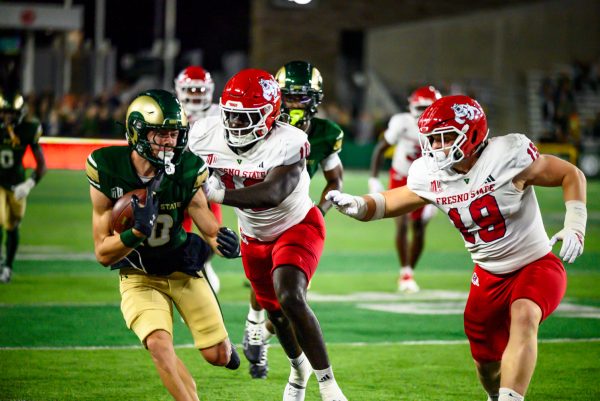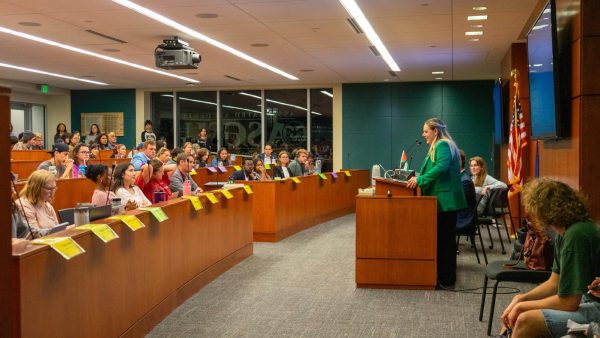‘If Rams took care of Rams, this wouldn’t happen on college campuses’: A survivor’s experience with the Title IX justice system
Collegian | Trin Bonner
December 5, 2022
Editor’s Note: Trigger warning: This story contains graphic depictions of sexual assault. All names have been changed.
Belle Simonds considered herself a normal 18-year-old first-year student at Colorado State University in fall 2021.
Simonds, a self-described animal lover from California, is a zoology major. She worked at a dog rescue in high school and said she loves to give back to both people and animals.
“Personally, I’m very bubbly,” Simonds said. “I try to be the happiest that I can be around people pretty much all times.”
Simonds’ first year of college started normally — until a direct message set a spiral of events into motion that would drastically alter her life.
During the first week of classes, Simonds received an Instagram direct message from a 22-year-old student named Dylan Whittle saying he thought she was cute and wanted to get to know her better. Simonds, who enjoys making friends, started to message with him.
“I love making friends; that’s not usually a problem for me,” Simonds said. “And at first, I was a little skeptical because I was thinking, ‘Who DMs people anymore?’ Every time he texted me, it took me a couple of days to respond just because I’m not very active on social media.”
Whittle would ask Simonds to go for drives — something she wasn’t comfortable with — so eventually Whittle invited Simonds to a party at his fraternity. She and her friends attended to meet him in person.
“At that party, he roofied me,” Simonds said. “I noticed, like, a weird, chalky consistency in my drink. I asked my friend, ‘Is yours the same way as well?’ and she said, ‘No, not at all.’ So I dumped it out immediately.”
Simonds and her friends left the party and went back to her dorm. Whittle later called her and asked her to come over to meet his roommates.
“I thought, ‘Yeah, that’s a great opportunity for us to get to know each other better,'” Simonds said. “When we got there, he led me directly into his bedroom. All the lights were off; his roommates were not there.”
“He put a movie on, and then he began to make out with me, which I was fine with — I consented to that part,” Simonds said. “However, he then started to touch me in places that I wasn’t comfortable with. I asked him to stop, and he stopped at first. And then he’d start to choke me sexually, and I didn’t really like that. So again, I asked him to stop.”
When the movie finished, Simonds asked Whittle to take her home. Whittle agreed and asked if she needed anything before they left. She asked for a glass of water, and he went into his bathroom to get the water, which Simonds noted was odd.
“I thought that was a little strange because the kitchen was right outside his bedroom,” Simonds said. “And about fifteen minutes after I drank the water, I completely passed out, and I do not remember what happened the rest of the night.”
Simonds said she woke up one time during the night to find Whittle on top of her, kissing her and choking her to the point of her physically blacking out. Simonds had no idea what was happening.
“It was definitely very scary,” Simonds said. “At the same time, it was better than understanding that I couldn’t move or say anything to get help. My body was in that state of not being able to comprehend anything that was going on. The best way to describe it is when you’re going under anesthesia, where you can’t move; you can’t speak; you can’t scream for help.”
When Simonds woke up in the morning, Whittle would not let her go home. She frantically left his apartment after saying she hadn’t taken her medication the previous night.
All Simonds wanted to do was take a shower, but she didn’t want to wake her roommate up, so she grabbed her AirPods and went on a walk, calling the only person she could think of who would be awake that early: her grandfather.
“He asked me why I had makeup all over my face,” Simonds said. “I was thinking, ‘That’s strange. I already wiped all the makeup off from night prior.'”
When she returned to her dorm and finally went to take a shower, she discovered the “makeup” on her face was bruising.
“There was a huge bruise under my eye that was black, and then throughout the day a handprint around my neck became more progressive; the fingerprints got darker and darker,” Simonds said. “It was just four fingerprints on one side and his thumbprint on the other side.”
Simonds covered the injuries with makeup and kept telling herself it was an accident.
“(Whittle) would apologize profusely,” Simonds said. “He started to gaslight me to make me feel bad, saying that he just wanted to spend time with me.”
Several weeks later, Whittle texted Simonds a frantic apology asking her to come to his fraternity formal as a public place to talk and to work things out. Simonds, who wanted to forgive Whittle after befriending his roommates, agreed to attend.
After the dance, Whittle took Simonds back to his apartment again, which she never agreed to. Once again, Whittle overpowered Simonds and began asking her to take things further and touching her without her consent, forcing her to do sexual things to him several times that night. She was sober and brought her own water to be safe.
“When he finally took me home, that was the time that I realized, ‘OK, he’s a really bad person, and I need to stop hanging out with him,'” said Simonds, who was still trying to process what had happened to her.
The following day, Simonds texted Whittle saying she didn’t want to maintain connection with him anymore.
“Even if there isn’t enough evidence for law enforcement to proceed, still proceed with the case because you never know if your case could help down the line in another investigation. Even if reporting what happened feels wrong — and it felt wrong for me — still go through with it. At the end of the day, I didn’t tell the cops and go through with the investigation for myself. I did it for the other girls that he had hurt and for the other girls that he could potentially hurt.” –Belle Simonds
A few weeks later, Simonds was contacted by her resident director, who told her one of her roommates was concerned about her and reported what was going on to the resident assistant. RAs are mandated reporters in instances of sexual assault and are required to report incidents to their building’s RDs.
The RD sat Simonds down and had her call the Victim Assistance Team hotline number. The Women and Gender Advocacy Center, which runs the VAT hotline, connected Simonds with an advocate, and later that week, she sat down with her advocate and told her story for the first time.
“That’s when I found out that … in both cases, I hadn’t consented, so this was rape and sexual assault,” Simonds said. “It was difficult for me to process these things.”
The emotional impact of this discovery weighed heavily on Simonds and led to a friend calling the CSU Police Department out of concern for her.
“In my head, I just kept thinking, ‘This is all my fault,’ convincing myself that if I never went over there, it would have never happened,” Simonds said. “I was gaslighting myself into thinking I was the reason this happened — that it was because of the amount of makeup I was wearing or the way my hair was. It wasn’t about my clothes because both nights I’d been in leggings, high-top Converse and a baggy sweatshirt.”
Simonds was convinced her choices had led to things spiraling out of control with Whittle.
“As a freshman in college, this is a whole new world, and I was trying to figure out if I liked the way my body was or if I needed to lose weight or if I should change my style,” Simonds said. “I dress very tomboyish, and I kept thinking that maybe because I started dressing more girly, maybe that’s why he pursued me more — or maybe it was because I told him I was going to lose all this weight. I constantly told myself that it was all my fault.”
CSUPD could not do much with Simonds’ case because the assault occurred in an off-campus apartment, so the case was turned over to Fort Collins Police Services, who took her statement right after winter break. The District Attorney’s office began an investigation following her statement.
Because she had not gotten a sexual assault nurse examiner kit done after either event, the DA’s office said not much could be done, which was incredibly frustrating to Simonds.
“I feel that with most people that end up in my situation, your first thought isn’t, ‘Oh, I need to get (a SANE kit) done,'” Simonds said. “It takes you a while to fully process what had happened, and that had been the case for me. I made the report three months after the initial event and a month after the second, so there was a lot of time and in-between for things to heal.”
The medical evaluation was able to find that Whittle had punctured Simonds’ jugular vein, hence the extreme bruising on her neck. However, despite the text messages, calls and photos, the DA’s office determined there wasn’t enough evidence to proceed, and the case was turned over to the Office of Title IX Programs and Gender Equity at CSU.
Simonds was more confident in the Title IX process and said she believes the amount of evidence she presented has contributed to the investigation.
The Title IX process for a student-reported sexual assault case follows a flow of seven steps, from the initial report being received to a hearing and decision, according to the Office of Title IX at CSU.
Through Title IX, if a perpetrator is found guilty, sanctions can be placed on them, according to the Office of Title IX’s website.
This is different from legal proceedings, wherein a person guilty of rape could be convicted of a felony and a lifetime registered sex offender status, according to Colorado law.
While less drastic than legal proceedings, Title IX sanctions could result in expulsion, withholding a diploma, disciplinary probation and loss of good standing, according to the Student Resolution Center.
“It was frustrating knowing that the justice system couldn’t do enough for me,” Simonds said. “But I’m trying to stay as hopeful as I can with Title IX.”
Since then, Simonds has connected with several support groups through the WGAC. She’s met others who knew of Whittle’s reputation and has grown comfortable sharing her story.
“It’s really great to have that community here at CSU and just be able to know that we’re not alone,” Simonds said. “It sucks knowing that other people have gone through similar events, like traumatic events; however, it’s nice to know that we’re not alone and that there is a community there for us in order to feel safer.”
Simonds now works with the WGAC and has shared her story and experience of still having her abuser on campus in front of a VAT training class as well as a panel consisting of members of a board of directors from around the university.
Even though Simonds was nervous to testify in front of both groups, she said the experiences helped her feel more at peace and become more comfortable sharing her story.
“One of the biggest takeaways for me was when someone on the panel said, ‘Rams don’t take care of Rams,'” Simonds said. “Honestly, that has held true because if Rams took care of Rams, this would not happen on college campuses.”
The path to healing has been long and difficult, and Simonds’ Title IX case remains open a year later.
“Even if there isn’t enough evidence for law enforcement to proceed, still proceed with the case because you never know if your case could help down the line in another investigation,” Simonds said. “Even if reporting what happened feels wrong — and it felt wrong for me — still go through with it. At the end of the day, I didn’t tell the cops and go through with the investigation for myself. I did it for the other girls that he had hurt and for the other girls that he could potentially hurt.”
Simonds said her biggest source of support is her current partner. She said the energy he has put into maintaining a normal friendship and romantic relationship with her following her assault as well as understanding what happened while not treating her like a permanently broken person have helped her heal the most.
Her advice to fellow survivors is to find sources of strength in their lives and to never give up.
“I would tell other survivors to keep their heads up and just know that everything will eventually get better,” Simonds said. “It does take time and effort, and I’m still putting that work into wanting to get better. However, they need to know that they’re not alone and that there’s so many people within not only the CSU community but the community in general that have all been through similar situations. We’re there to support people and also give them the opportunity to share their story if they’re ready.”
Reach Allie Seibel at news@collegian.com or on Twitter @allie_seibel_.









Sammy Trout • Dec 9, 2022 at 8:45 pm
I wish the absolute best for Belle and other survivors on campus. Thank you for your bravery in sharing your experience. I’m so glad the Collegian took this story and I hope this helps other survivors in their journeys knowing that they are not alone <3
Christian Kilburn • Dec 5, 2022 at 1:41 pm
This is incredibly brave, I appreciate you sharing your experience and hopefully making people feel less alone in their experiences.
Alex Silverhartg • Dec 5, 2022 at 10:16 am
I really appreciate people sharing their stories and helping people realize they are not alone. I am an RA and being a responsible employee is a tough task, but I am glad the RA did their job. Sexual assault is not something that should go unnoticed.